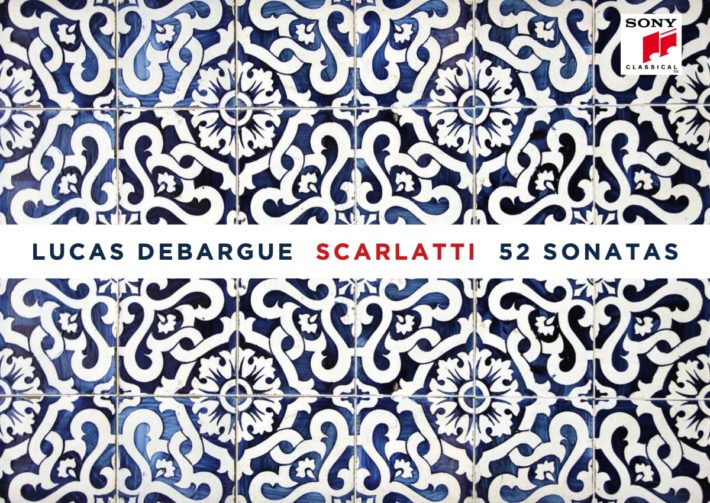A pair or two of Scarlatti sonatas in a carefully curated recital album can elevate a program, bringing joy or uplifting color, as Vladimir Horowitz taught us and Yuja Wang’s albums highlight. Albums of Scarlatti can become tiresome without careful consideration to contrast keys, tempi, textures, and the intrinsic details which make his music sparkle. To present four hours of a single composer on one instrument requires a listener with certain interest and determination. In his latest Sony release, pianist Lucas Debargue explores a single musical form — the sonata, from a single composer — Scarlatti.
Debargue begins with an expansive sonata K.206, in which one hears all the features of his interpretative style; a dominant right-hand, balanced left-hand accompaniment, highly articulate playing and securely executed ornaments; dynamics are subtly distinctive. As the album unfolds, the uniformity of approach becomes apparent and highly consistent. Whilst some sonatas are slower than expected, others are too brisk, such as K.27. Here the depth of emotion is missing, especially compared to Anne Queffélec’s more lyrical approach. While the broader approach of K.491 has a sense of style, it misses a militaristic drama in some episodes.
His right-hand staccato is slightly percussive, with uniform color. His left-hand is appropriately balanced, coming to the fore when necessary, as in K.125 (disc 3, track 2). however, it does lack the shape of phrasing in the less musically sophisticated passages. There are inconsistencies in tone at times, for example is K.212 and K.404 higher notes jar, or in K.268 and K.244, where the brittleness of tone becomes evident. Dynamics, whilst subtle, are at times too delicate as in K.447. There are also some illuminating contrasts. K.109 has some vivid dynamics which bring the sonata to life. Ornaments are stylistically executed throughout and enhance the beauty of Scarlatti’s lines, as in K.253, which is one of the most spirited performances in this release. In K.534, the imitation of ornaments between the hands is executed with precision. Some of the sonatas have an improvisatory quality, and a welcomed sense of spontaneity, as in K.6 or K.343.
Debargue’s artistry and connection with the music are evident. His overall approach is metered and leveled, but colors coming from his instruments are often monochromatic, lacking poetry some pianists find in this repertoire. Anne Queffélec’s remarkable survey of selected Sonatas aptly demonstrates how to open the doors and invite one in to share the musical journey, whereas Debargue is much more self-contained and aloof. Queffélec showcases her virtuosic capabilities in playing repeated notes (a feature of Scarlatti’s compositional style), with dazzling dexterity and a sense of direction. Throughout her 1970 performance, there is an air of sophistication as she brings poetry. Ivo Pogorelich’s single album is varied, bringing his quirky, idiosyncratic character to the fore in his selection. Mikhail Pletnev brings a different perspective — expressive and captivating, demonstrating the potential of what can be achieved with attention to the left-hand phrasing and a touch of pedal.
Recorded in Berlin-Dahlem, Jesus-Christus-Kirche, over a week during September 2018, the acoustic is enhancing the listening experience and is unintrusive. The piano sound itself is captured well and is consistent across the release, but there is extraneous noise at times, as in K.461 and K.469, which becomes distracting.
With four discs of Scarlatti in this album (if buying the physical copy), it is not one to be savored from beginning to end in a single sitting. There are a few popular sonatas littered across the program, but these are insufficiently frequent to punctuate the homogeneous trawl of lesser-known ones successfully. Debargue’s tempo choices lack the stark variants of tempo needed to break the sense of pedestrian monotony. Slower sonatas — desperately needed for a respite and expressive variety, are few in number. Whilst the choice of sonatas showcases Debargue’s obvious skills, they don’t contrast like Yevgeny Sudbin’s varied selection or Angela Hewitt’s. The third of Debargue’s discs, if listened to in isolation, has the most musically satisfying selection of sonatas overall. Apart from reference material for musicians and enthusiasts, this is more of a library acquisition for selective sampling.

Scarlatti – 52 Keyboard Sonatas
Lucas Debargue – Piano
Sony Classical, 4 CDs , Catalog No. 19075944462
Scarlatti Keyboard Sonatas – Comparisons
Follow Us and Comment:
Get our periodic classical music newsletter with our recent reviews, news and beginners guides.
We respect your privacy.








